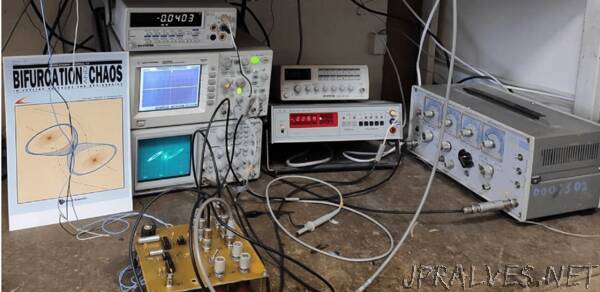
“Scientists from St Petersburg University and the Kotelnikov Institute of Radioengineering and Electronics of the Russian Academy of Sciences (IRE RAS), together with Professor Leon Chua from the University of California, Berkeley, have demonstrated experimentally the existence of hidden attractors — points in the basins of attraction in a simple electrical circuit.
An attractor in a dynamical system is a set of states toward which the system tends to evolve over time. One of the examples of systems with trivial attractors is a roly-poly toy. The attractor here will be an upright position, the so-called state of rest. Another example is a swinging pendulum, for which the attractor will be the pendulum’s equilibrium position when it hangs vertically.
However, there are also attractors of another type: chaotic attractors. For systems with chaotic attractors, trajectories for the passage from equilibrium to attractor are more difficult to predict. One of the key tasks of nonlinear dynamics as a scientific direction is to reveal all possible limiting dynamical regimes of oscillations (non-trivial attractors) and the initial conditions from which the trajectories tending to hidden attractors start.
In turn, non-trivial attractors can be hidden or self-excited. Self-excited attractors are easy to detect and localise in a physical experiment and by numerical analysis.
For example, the onset of respiration at birth is the result of self-excitation of the lungs. From a state of rest, the respiratory organs come to a stable cycle mode of operation, which corresponds to a self-excited attractor.
For humans, breathing is cyclic and automatic. In case of respiratory failure, however, it is necessary to restart respiration. For this, it is essential to determine the appropriate level of impact on the respiratory organs in order to return the respiratory system to the basin of attraction of the stable cycle mode of the lung and heart function. In this case, the initial state of equilibrium is stable and continuous breathing corresponds to a hidden periodic attractor.
Since then, many different forms of chaotic oscillations have been identified in the Chua circuit. All of them, however, were self-excited attractors that could be observed when the circuit is switched on at the zero initial data, corresponding to the zero equilibrium state. Hence, a conjecture was that the chaotic behaviour is possible only in the case of unstable zero equilibrium.
Later, Professor Nikolay Kuznetsov, Head of the Department of Applied Cybernetics at St Petersburg University, predicted the existence of hidden attractors. Back in 2009, he mathematically proved the existence of hidden chaotic attractors in the Chua circuit.
The existence of hidden attractors in the Chua circuit was experimentally confirmed at the Saratov branch of the Kotelnikov Institute of Radioengineering and Electronics of the Russian Academy of Sciences (IRE RAS). To this end, the scientists from IRE RAS and St Petersburg University, together with Professor Chua himself, designed a special experimental setup to validate the mathematical models. The setup features an additional sub-circuit included in the classical Chua circuit, which enables simulation of the impact of external disturbances, allowing for selection of the initial conditions at the moment of starting the setup.
In a radiophysical experiment, the scientists ran the modified Chua circuit and were able to detect and visualise attractors that can be considered hidden because at the initial — unmodified — conditions, they are not observed.
According to Professor Kuznetsov, the discovery is important not only for fundamental science. It makes possible many practical applications. For example, the chaotic oscillations generated in the Chua circuit can be used as a random number generator in encryption systems for covert data transmission and in many other applications. Thus, various memristive system technologies based on Chua’s theory have been developed. Memristors, being non-volatile memory devices, can become the basis for a new generation of computers, in which the storage and processing of data is carried out by the same physical device.”
